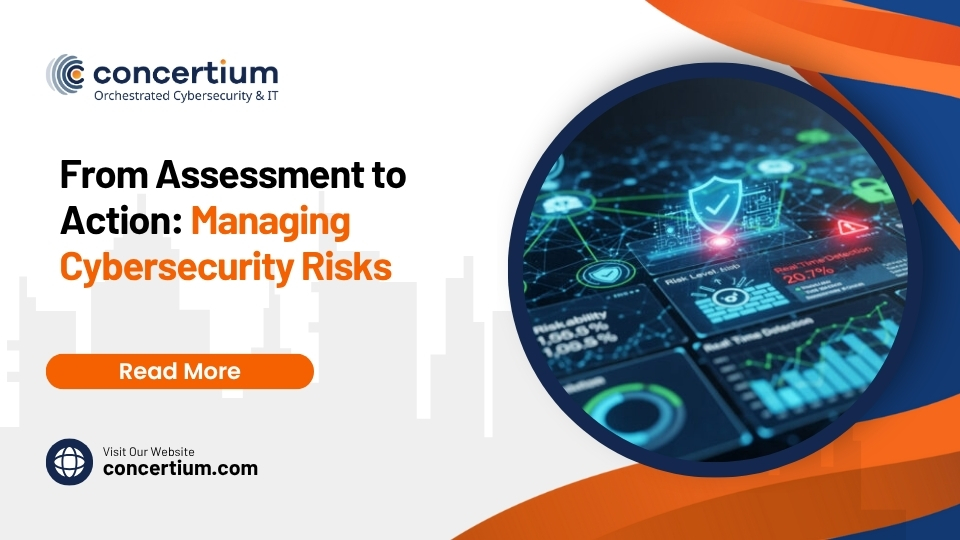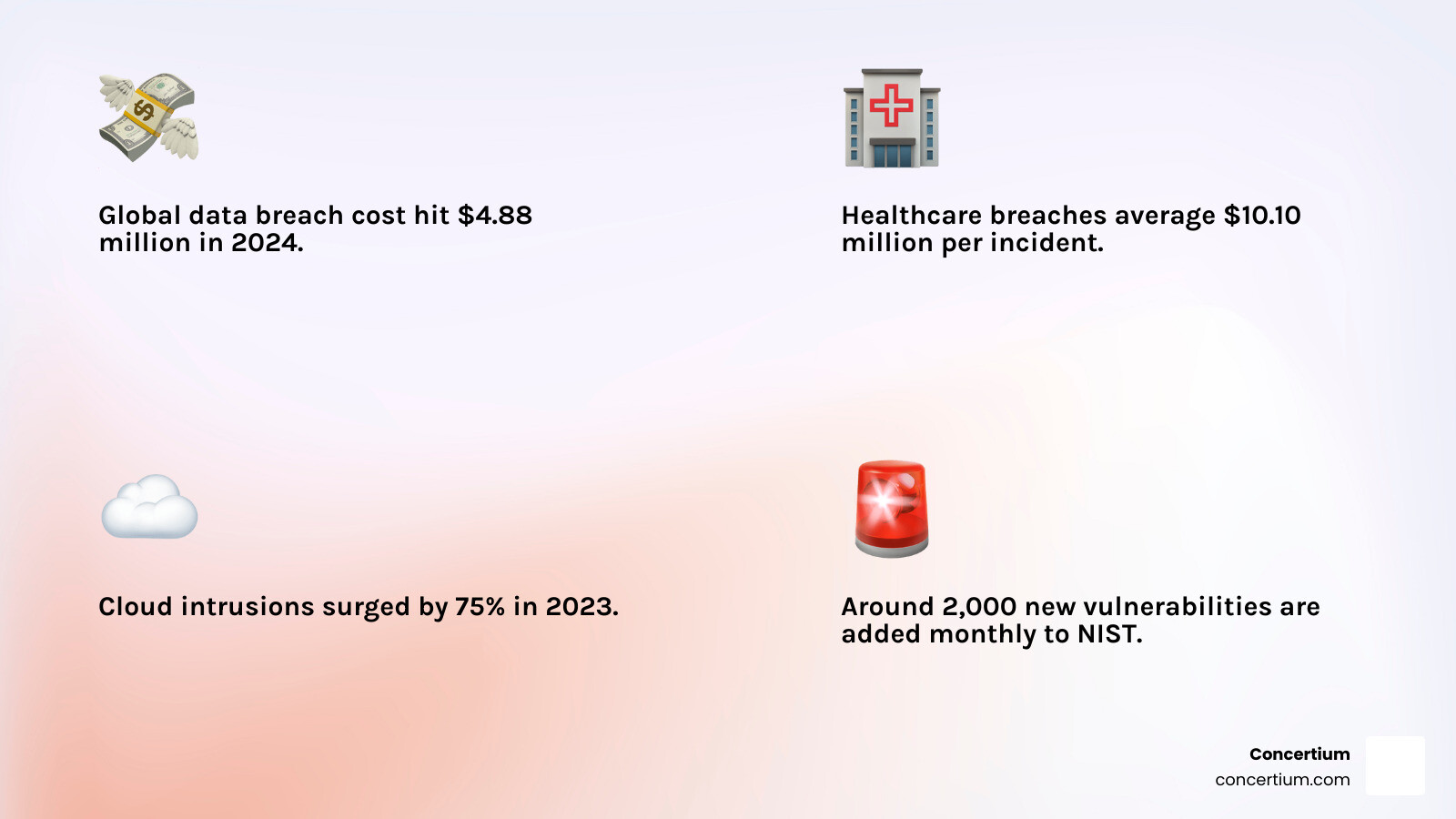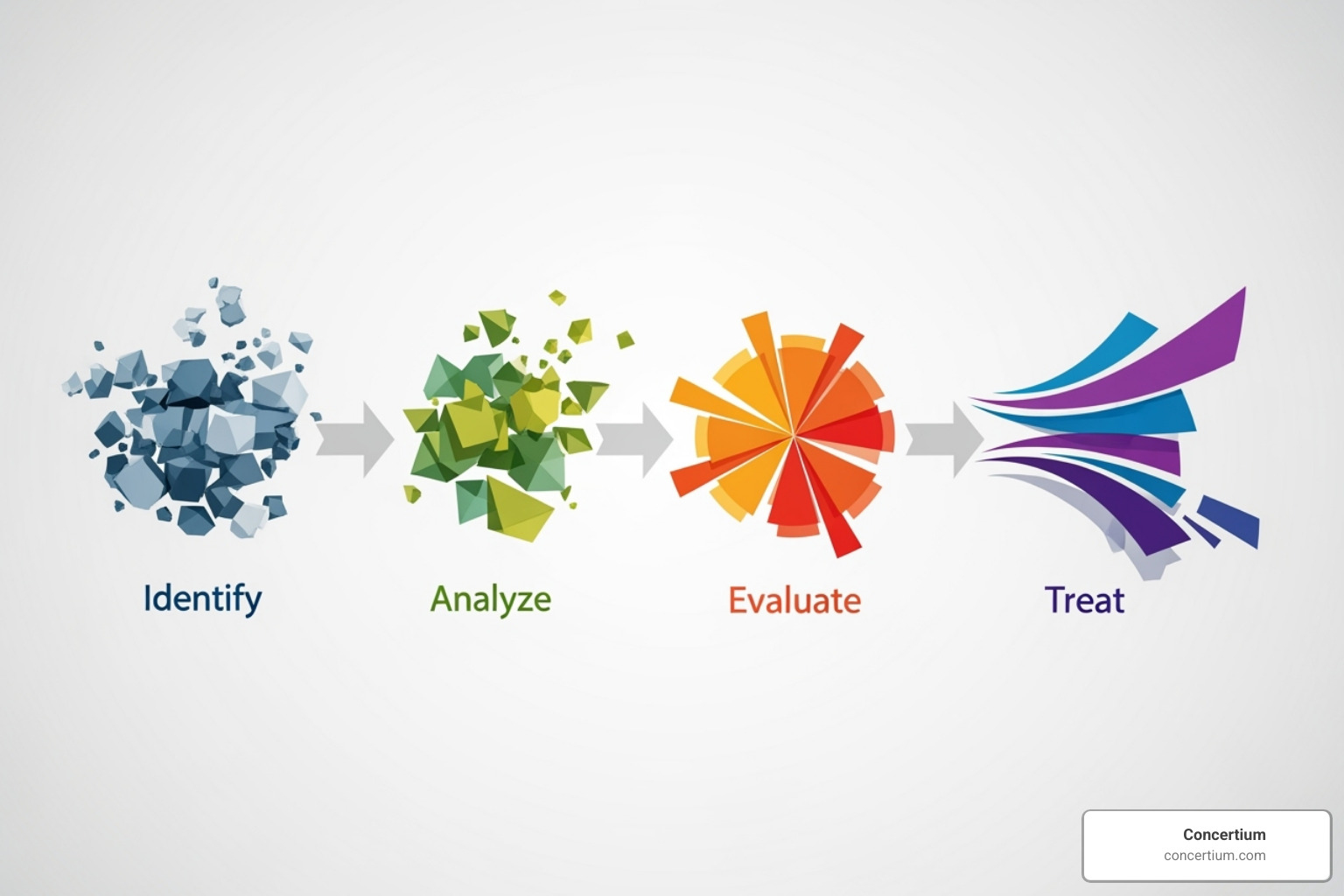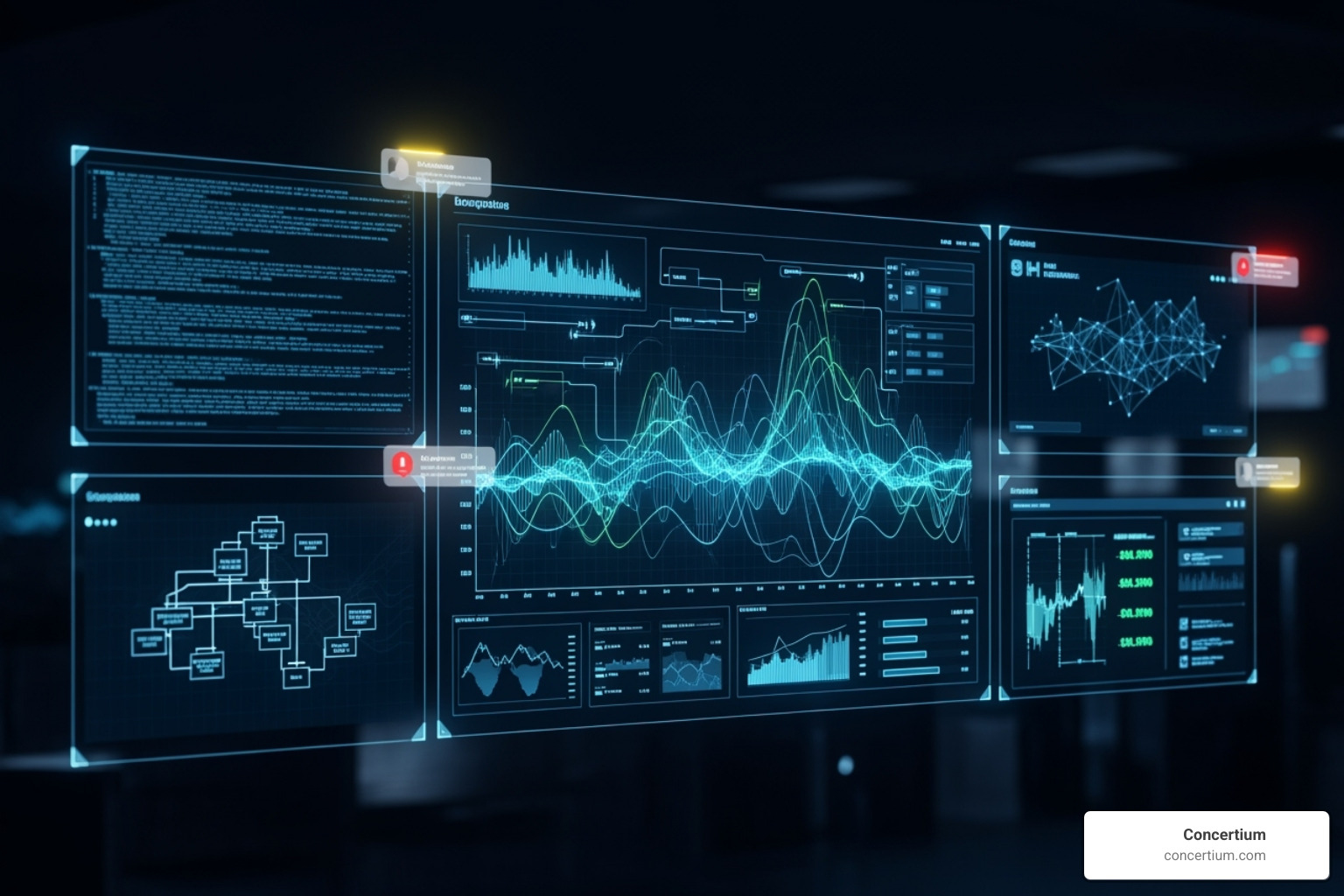Risk assessment and management in cyber security is the systematic process of identifying, analyzing, and responding to potential threats that could harm your organization’s data, systems, and operations. Here’s what this process involves:
Core Components:
- Asset Identification – Catalog critical systems, data, and resources
- Threat Analysis – Identify potential attack vectors and vulnerabilities
- Risk Evaluation – Assess likelihood and business impact of threats
- Response Planning – Implement controls to mitigate, transfer, avoid, or accept risks
- Continuous Monitoring – Regularly review and update security posture
The stakes couldn’t be higher. The global average cost of a data breach reached $4.88 million in 2024, with healthcare organizations facing even steeper costs at $10.10 million per incident. Yet only 24% of organizations have secured their AI initiatives, while cloud intrusions increased by 75% in 2023.
Consider this scenario from recent research: “Imagine a mid-sized business that believed it was too small to be targeted by cybercriminals. One day, its entire network is locked by ransomware, paralyzing operations for days and causing significant reputational damage.”
This reality check highlights why proactive risk management isn’t optional anymore. With roughly 2,000 new vulnerabilities added to the NIST database monthly and the average company sharing confidential data with 583 third parties, the attack surface keeps expanding.
Modern businesses face threats from multiple angles – cybercriminals, nation-states, insider threats, and simple human error. Without a structured approach to identify these risks and implement appropriate safeguards, organizations are essentially flying blind in an increasingly dangerous digital landscape.
Must-know risk assessment and management in cyber security terms:
Preparing for Success: The Foundations of a Strong Risk Assessment
Preparing for a cybersecurity risk assessment requires thoughtful planning. Risk assessment and management in cyber security is a systematic process that starts with a solid foundation.
First, define your scope: are you assessing the entire organization, a single department, or a new cloud system? Clear boundaries prevent missed assets and overwhelming scope creep. Next, secure stakeholder buy-in. Cybersecurity involves everyone, so input from leadership, department heads, and end-users is essential to identify what truly matters.
Understanding your organization’s risk appetite is also key. Some companies are cautious, while others accept more risk for innovation. Knowing your position on this spectrum guides the entire assessment. Finally, consider compliance requirements. Regulations like GDPR, HIPAA, and PCI DSS are mandatory. Your assessment must address these legal obligations to avoid serious penalties. Professional Risk Advisory Services in Cybersecurity can help steer these complexities.
Why a Cybersecurity Risk Assessment is Crucial for Your Business
Risk assessments deliver benefits that can save your business by identifying issues before they become costly disasters.
- Improved security posture: Regular assessments find weak spots before attackers do, allowing you to fix vulnerabilities proactively.
- Cost savings: With data breaches costing millions, the investment in risk assessment pays for itself by preventing incidents, regulatory fines, and long-term reputational damage.
- Regulatory compliance: Assessments make it easier to meet requirements like GDPR and HIPAA, maintaining customer trust.
- Smarter business decisions: A clear understanding of your risk profile helps you allocate resources effectively and prioritize security investments.
For organizations seeking to protect their future, professional Cybersecurity Risk Assessment Services offer invaluable expertise and objectivity.
Choosing Your Framework and Approach
You don’t have to start from scratch. Proven frameworks can guide your risk assessment process. The key is choosing one that fits your organization’s size, industry, and complexity.
- NIST Cybersecurity Framework (CSF): A flexible and widely adopted gold standard built around five core functions: Identify, Protect, Detect, Respond, and Recover.
- ISO 27005: A formal, detailed standard for information security risk management, ideal for organizations pursuing ISO 27001 certification.
- FAIR methodology: A quantitative approach that translates cyber risks into financial terms, helping justify security investments to business leaders.
Many organizations use a hybrid approach, combining faster qualitative analysis (high, medium, low) with detailed quantitative analysis for the most critical risks. The best framework is one your team will use consistently. We help organizations choose and customize frameworks, turning your risk assessment into a valuable business tool. Learn more through our Cybersecurity Risk Management Frameworks services.
The 4-Step Cybersecurity Risk Assessment Process
With the groundwork laid, it’s time to dive into the core of risk assessment and management in cyber security. This roadmap simplifies a daunting process into four key stages: identifying assets, understanding threats, evaluating potential damage, and prioritizing action.
This systematic approach provides the clarity needed for an effective Conduct Vulnerability Risk Assessment.
Step 1: Identify and Catalog Your Critical Assets
You can’t protect what you don’t know you have. This step involves creating a comprehensive inventory of everything valuable to your business. This includes:
- Information systems: Servers, databases, network devices, cloud instances, and legacy systems.
- Data: Classify data to identify your crown jewels—the critical information that keeps your business running.
- Hardware and Software: Catalog all laptops, mobile devices, applications, and operating systems, as each is a potential entry point.
- People: Employees, contractors, and third-party vendors are also assets with access to your systems. Understanding these human touchpoints is crucial for a complete Enterprise Security Risk Assessment.
Step 2: Pinpoint Threats and Vulnerabilities
Once you know what to protect, you must identify what you’re protecting it from. This involves looking at both current and future possibilities.
Threat sources are varied and include:
- Malicious actors: Cybercriminals, nation-states, and disgruntled insiders.
- Human error: Accidental clicks on phishing emails or misconfigured cloud storage.
- Natural disasters and system failures: Events like floods or hardware malfunctions.
Vulnerabilities are the weaknesses that threats exploit, such as unpatched software, weak passwords, or a lack of employee training. Resources like the NIST National Vulnerability Database and the MITRE ATT&CK framework help identify emerging threats. Our Vulnerability Risk Management services help you stay ahead of these evolving risks.
Step 3: Analyze Likelihood and Business Impact
This step involves determining how likely a threat is and what the consequences would be. Likelihood analysis uses historical data and threat intelligence to estimate probabilities. Impact analysis assesses the potential damage across several areas:
- CIA Triad: How would a breach affect the Confidentiality, Integrity, and Availability of your data and systems?
- Financial Impact: Consider lost revenue, recovery costs, and regulatory fines.
- Operational and Reputational Impact: Evaluate system downtime and the long-term damage to customer trust.
A risk matrix is a useful tool to visualize the relationship between likelihood and impact, helping to identify which risks require immediate attention.
Step 4: Determine and Prioritize Risks
Finally, combine your analysis to create an actionable plan. Risk calculation (Risk = Likelihood × Impact) provides a score to help categorize threats as critical, high, medium, or low. This risk scoring must be aligned with your organization’s risk appetite—the level of risk you are willing to accept.
Prioritization is key. Focus on risks that exceed your tolerance levels first. This creates an actionable risk list that guides remediation efforts and ensures resources are allocated effectively. You can’t fix everything at once, so prioritizing based on calculated risk is essential for improving your security posture. Our Risk and Compliance Advisory services can help guide this critical process.
Taking Control: Effective Cybersecurity Risk Management and Response
Analysis is valuable, but action is what provides real protection. In risk assessment and management in cyber security, this phase is called risk treatment, where insights are transformed into concrete security measures. This is the difference between knowing about a problem and solving it.
Our Governance, Risk, and Compliance (GRC) Strategies are designed to guide organizations through this critical implementation phase.
Choosing the Right Risk Treatment Strategy
For every prioritized risk, you must decide on a course of action. There are four main strategies, and the right choice depends on your resources, risk appetite, and a careful cost-benefit analysis.
- Mitigation: The most common strategy. Implement controls to reduce the likelihood or impact of a threat. Examples include installing multi-factor authentication or creating robust backup systems.
- Transfer: Shift the financial burden to a third party. Cyber insurance is a primary example, but this can also involve outsourcing high-risk activities to specialized vendors.
- Avoidance: Eliminate the risk by discontinuing the activity that causes it. This could mean decommissioning a vulnerable legacy system or canceling a high-risk business venture.
- Acceptance: Consciously decide to live with a risk. This is typically for low-impact, low-likelihood risks where the cost of mitigation outweighs the potential damage. This decision must be documented and approved by leadership.
Implementing Security Controls to Mitigate Risk
When you choose mitigation, security controls are your primary tools. An effective strategy uses a combination of all three types:
- Technical Controls: Technology-based safeguards like firewalls, multi-factor authentication (MFA), and encryption. Modern solutions like intrusion detection systems and endpoint protection platforms are also critical.
- Administrative Controls: The policies and procedures that govern human behavior. This includes employee training on phishing, access policies to enforce least privilege, and well-rehearsed incident response plans.
- Physical Controls: Measures that protect physical infrastructure, such as locked server rooms, security cameras, and access badges.
Effective implementation is key. Our Cybersecurity Risk Management Tools help organizations deploy and manage these controls over time.
The Role of Documentation in Risk Assessment and Management in Cyber Security
Proper documentation is your organization’s institutional memory and legal protection. Without it, you risk compliance issues and lose track of your security posture.
- Risk Register: A central repository that details each risk, its likelihood and impact scores, the chosen treatment strategy, and its current status. This is your roadmap for managing an evolving threat landscape.
- Documented Decisions: Formally record all risk treatment choices, especially risk acceptance, to ensure transparency and accountability.
- Audit Trails: Maintain logs of security events, system changes, and user access. These are invaluable for forensic investigations and proving compliance.
- Communication Plan: Ensure the right information reaches the right people, from detailed technical guidance for IT teams to high-level summaries for executives.
Thorough documentation is the foundation of a coherent, defensible security program and is central to our Compliance Risk Management Services.
The Continuous Cycle of Risk Assessment and Management in Cyber Security
Cybersecurity is not a one-time project; it’s an ongoing process. Risk assessment and management in cyber security must be a continuous cycle because the moment one assessment is complete, new threats emerge and the digital landscape shifts.
This ongoing cycle of assessment, action, and monitoring is the core of resilient IT Governance, Risk, and Compliance and separates proactive organizations from reactive ones.
Why Continuous Monitoring is Non-Negotiable
Treating cybersecurity as a static defense is a recipe for disaster. The digital world is in constant flux, requiring continuous vigilance.
- Dynamic Threat Landscape: Cybercriminals constantly innovate. Hands-on attacks jumped 60% in 2023, and emerging AI threats and cloud security risks create new attack surfaces daily.
- New Vulnerabilities: Roughly 2,000 new vulnerabilities are added to the NIST database monthly. Without continuous monitoring, systems are exposed to threats that didn’t exist during the last assessment.
- Business Changes: New products, employees, and technologies all introduce or alter risks. Each change requires a re-evaluation of your security posture.
- Evolving Compliance: Regulations change, and auditors expect to see current, relevant security measures, not an outdated report.
Continuous monitoring is a proactive radar system that is essential for maintaining an effective Process of Vulnerability Risk Management.
Building a Culture of Risk Awareness
Technology alone is not enough. Cybersecurity is a team sport, and your employees are your most critical line of defense.
- Engaging Training: Go beyond boring annual presentations. Effective security training programs make cybersecurity relevant to employees personally, turning them into invested partners. Phishing simulations are a powerful tool to reinforce this training.
- Shared Responsibility: Cybersecurity is everyone’s job. From accounting to HR to marketing, every department plays a role in protecting the organization’s data and systems.
- Security Integration: Bake security into daily operations. This means considering security from the start of new software development projects and evaluating vendor security during procurement.
- Top-Down Support: Leadership must champion cybersecurity, providing the necessary resources and setting the tone for the entire organization.
When risk awareness becomes second nature, your people become proactive human firewalls. This is the ultimate sign that your risk assessment and management in cyber security strategy is working.
Conclusion
The path of risk assessment and management in cyber security isn’t just about ticking boxes or meeting compliance requirements – it’s about building a foundation that lets your business thrive, even when digital storms hit.
Think about it this way: we’ve walked through the entire journey together, from understanding why cybersecurity risk management matters (remember those $4.88 million average breach costs?) to building the frameworks that keep threats at bay. We’ve explored how to identify what matters most in your organization, spot the dangers lurking in the digital shadows, and create actionable plans that actually work.
But here’s the thing – this isn’t a “set it and forget it” situation. The cyber landscape changes faster than fashion trends, and what worked yesterday might leave you exposed tomorrow. That’s why continuous improvement isn’t just a nice-to-have; it’s your lifeline in an ocean of evolving threats.
The real magic happens when you move from assessment to action. All the risk registers and vulnerability scans in the world won’t help if they just sit on a shelf gathering digital dust. The organizations that succeed are the ones that turn insights into implementation, and theory into practice.
At Concertium, we’ve seen this change happen countless times over our nearly three decades in cybersecurity. Our Concertium expertise comes from walking alongside organizations just like yours, helping them steer from vulnerability to resilience. Our Collective Coverage Suite (3CS) with AI-improved observability doesn’t just spot problems – it helps solve them automatically, giving you the breathing room to focus on growing your business instead of constantly fighting fires.
The truth is, you don’t have to face these challenges alone. While the cyber threat landscape can feel overwhelming, having the right partner makes all the difference. We don’t just hand you a report and walk away – we work with you to build something stronger, something that grows with your business and adapts to tomorrow’s threats.
Your organization’s security journey doesn’t end here – it evolves here. Take that next step toward comprehensive protection. Secure your organization with expert Cybersecurity Risk Mitigation.







